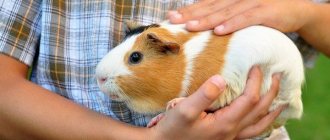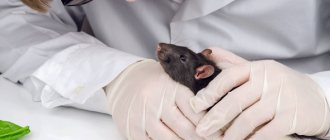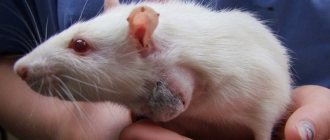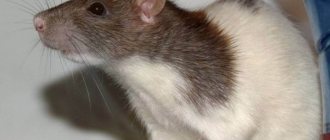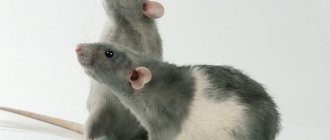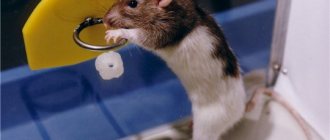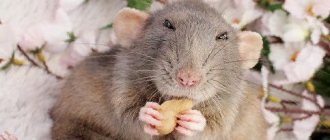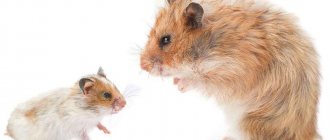How to tell if an animal is choking
By its very behavior the animal will make it clear that it has choked. It will wilt, its activity will be at zero, it will lie motionless, hanging its head down, or crawl away to a secluded place. The rat's body may shake slightly, as if it is having convulsions. The animal will make movements with its neck, stretching and contracting it, as if it wants to make a swallowing movement. Saliva may flow profusely from the mouth and foamy mucus may appear. These symptoms do not necessarily appear all together, so if any of them are present, the rat should be examined.
Features of the treatment of acute and chronic intoxication
It is important to correctly determine the type of intoxication, assess the severity of poisoning, identify concomitant diseases and general health. Most chronic intoxications can be treated at home by changing your diet and giving up bad habits. Workers in hazardous industries should think about changing their place of work. The first stage is cleansing the body. The second stage is the restoration of the normal functioning of the gastrointestinal tract, which can be considered as a single factory responsible for our health. Hepatoprotectors are prescribed as drug therapy to enhance the detoxification function of the liver and protect it from negative effects; alginates for binding and removing chemical elements and toxic compounds, liquid chlorophyll, sorbents and other detoxification agents.
How to help a rat if it is choking
- First , you need to inject the animal under the skin in the withers area with a mixture of prednisolone and furosemide (0.1 ml of each drug, 0.2 ml in total) or dexamethasone (0.1 ml). These medications will help prevent swelling of the throat; they should always be in a rat breeder's home medicine cabinet. Read about how to inject yourself in this article.
- Secondly , after the injection, use a cotton swab to clean the rat’s neck and mouth to remove mucus and food residues. To do this, the animal is fixed and wielded with a stick, inserting it into the rat’s mouth from the side - deeper (up to 2.5 cm), behind the incisors.
- Thirdly , after cleaning the throat and mouth, the animal must be shaken vigorously several times (holding it upside down) with top-down movements, as if about to throw it on the floor. At the same time, the rat must be held tightly so that it does not actually slip out of your hands and hit.
After these procedures, the pet should feel better - the object he choked on will either fall into the esophagus or fly out of the mouth. For greater effect, you can let the animal lick a drop of vegetable oil (preferably olive) from your finger - with it, the stuck piece will easily slip inside.
The fact is that these rodents do not have a gag reflex, therefore, if a rat chokes, in most cases, it cannot help itself. Not only a sick animal can choke, but also a greedy one. Especially if, pushing away his cage neighbors, he is in a hurry to be the first to grab the food. But, just in case, it would be a good idea to show the rat to a doctor. During the day after surgery to save your pet, you should not give it hard food. The injured pharyngeal mucosa should heal. You can feed your pet yogurt or canned food for small children for a day.
Did you like the article? Share with friends: [supsystic-social-sharing id=”1"]
- Related Posts
- Do rats get bathed?
- What to feed your pet rat
- Is it possible and how to trim a rat's claws?
« Previous entry
Why does a decorative rat have trouble breathing?
Wheezing in a rat, irregular breathing rhythm and the appearance of extraneous sounds when inhaling and exhaling indicate deadly heart or lung diseases in a domestic rodent, such as:
- Bronchitis;
- Pneumonia;
- Asthma;
- Mycoplasmosis;
- Heart failure;
- Heart attack or stroke;
- Neoplasms or abscesses in the lungs.
IMPORTANT!!! In domestic rats, against the background of increased metabolism, pathological processes develop rapidly; at home it is impossible to correctly diagnose the disease and cure the animal. Don’t waste time; if any breathing problems occur, immediately contact a veterinarian!
Respiratory and cardiovascular diseases often present with similar symptoms, but require completely different treatments.
Heart failure occurs in individuals of any age and manifests itself with a clear clinical picture:
- the pet rat quickly recovers, the animal develops a huge belly, or, conversely, the pet rapidly loses weight and the fur becomes ruffled;
- the rodent becomes less active, gets tired quickly during walks, sleeps more, and sometimes apathy is observed;
- the rat wheezes when breathing, coughs, and there is wet, labored breathing;
- the tips of the fingers and tail of the animal are cold and blue, weakness of the pelvic limbs appears.
Heart attack or stroke occurs in older rats and can be identified by the following symptoms:
- the animal falls on its side and convulses;
- the rat gasps and opens its mouth, trying to grab the air with its teeth;
- limbs move chaotically.
With immediate first aid, a heart attack can be stopped, but the prognosis for the disease is cautious. Sometimes there is sudden death of a pet. If the condition worsens, they often resort to euthanasia of the pet to alleviate the pain.
Respiratory diseases are one of the most common pathologies in decorative rats. The reason that a domestic rat grunts when breathing may be a banal draft or serious pathological processes in the lung tissue. Inflammatory lung disease (pneumonia) rapidly develops against the background of colds, mycoplasmosis, abscesses and tumors in the lungs and becomes a common cause of death in pets. The progression of pathological processes in the lungs is indicated by characteristic symptoms:
- the rat often sneezes and grunts through its nose;
- dried red-brown mucus is found on the nose and eyes of the animal - porphyrin;
- the rat breathes heavily and opens its mouth; when breathing, wheezing, gurgling, and coughing of varying intensity and humidity are observed;
- in advanced cases, the rat breathes heavily and frequently from the sides, whistling sounds appear;
- the animal characteristically hunches its back, moves little and sleeps often;
- the rodent refuses to eat, lethargy, apathy, tousled fur, a “sad” look, and mucous discharge from the eyes and nose are observed.
The prognosis for pneumonia, depending on the cause, is cautious or conditionally favorable. Treating a pet involves the use of antibiotics, hormonal and anti-inflammatory drugs, immunomodulators and vitamins; in advanced cases, the animal may die.
Why do guinea pigs die from overeating?
However, not all living beings are able to feel nausea and then empty their stomach through the mouth. Scientists have long known that rats, for example, never feel sick at all. Even if these animals swallowed a loading dose of rat poison, they will still die, but will not cleanse their stomachs in the usual way for us. Recently it was found that this is characteristic of all representatives of the order of rodents (Rodentia). By the way, this is why guinea pigs often die from gluttony - they simply do not have a mechanism that would quickly remove excess food from their body.
Treatment of postcholicystectomy syndrome
Since PCES is not an independent disease, treatment of the syndrome is always determined by its causes. Not knowing how to properly treat postcholicystectomy syndrome can only aggravate the condition and increase unpleasant symptoms.
The principles of treatment for PCES include two key points:
- collection of anamnesis data - the doctor carefully studies old medical reports and records, paying close attention to preoperative diagnostics and the protocol of the operation;
- eliminating the causes of the syndrome;
- prevention and treatment of suspected complications.
Treatment is mainly based on:
- diet therapy;
- drug treatment;
- surgery (according to indications)7.
Together with comprehensive treatment, these measures can reduce the severity of symptoms of PCES8.
Posts 1 page 30 of 30
Share12012-12-23 22:03:22
- Author: dep
- Participant
- From: Samara
- Registered: 2012-12-23
- Invitations: 0
- Posts: 13
- Age: 30 [1[1991-04-01]li>
- Time spent on the forum: 3 hours 47 minutes
- Last visit: 2013-01-13 19:42:08
In general, the rat choked. They took him to the vet at 10 o'clock at night. The doctor said that if she choked, it was something in the thoracic region. The rat salivates, but only periodically. She does not drink water even if it is poured into her through a syringe. He swallows air like a fish. Lethargic, cloudy eyes. The veterinarian gave an injection of antispasmodic, unfortunately I did not remember the name. No changes occurred within 2 hours. Still breathing heavily and swallowing air. We removed saliva from the mouth with cotton swabs, tried shaking it upside down, but nothing helped. The veterinarian advised us to take her to the hospital, but it’s only tomorrow morning, and the rat is suffocating. So I’m actually asking how to alleviate her condition until the morning??
Share22012-12-23 22:19:35
- Author: runa
- Administrator
- From: Donetsk
- Registered: 2009-08-15
- Invitations: 0
- Messages: 20590
- Female gender
- Time spent on the forum: 6 months 7 days
- Last visit: 2021-10-09 18:39:09
Are you sure you choked? before this there were no sneezes, grunts, purrs, or other sounds? no porphyrin was released?
It’s too bad they didn’t remember the name of the drug. although I don’t quite understand why an antispasmodic is needed in this case.
now you need to give her a piece of butter. If she can’t eat it herself, lightly drown it and pour it into her mouth. and give two injections. furosemide and dexamethasone. do you have them in stock? If you don’t have it, you should buy it at the pharmacy. this is a person drugs. + insulin syringes. and at least the approximate weight of the rat
Share32012-12-23 22:31:07
- Author: dep
- Participant
- From: Samara
- Registered: 2012-12-23
- Invitations: 0
- Posts: 13
- Age: 30 [1[1991-04-01]li>
- Time spent on the forum: 3 hours 47 minutes
- Last visit: 2013-01-13 19:42:08
before that there were no sneezes or grunts. The only food available was rat pellets (dry food). when they removed the saliva with a cotton swab, they shined a blue flashlight into her mouth. At the veterinary clinic, about an hour later, porphyrin was released. there was no more of him. The rat weighs approximately 300g and is 2 years old in April.
Share42012-12-23 22:34:38
- Author: runa
- Administrator
- From: Donetsk
- Registered: 2009-08-15
- Invitations: 0
- Messages: 20590
- Female gender
- Time spent on the forum: 6 months 7 days
- Last visit: 2021-10-09 18:39:09
furosemide - 0.1 ml i.m. dexamethasone - 0.07 ml i.m.
These drugs will relieve swelling and inflammation if they are there, and there most likely is swelling there.
Share52012-12-23 22:37:04
- Author: dep
- Participant
- From: Samara
- Registered: 2012-12-23
- Invitations: 0
- Posts: 13
- Age: 30 [1[1991-04-01]li>
- Time spent on the forum: 3 hours 47 minutes
- Last visit: 2013-01-13 19:42:08
Now let's try the oil and run to the pharmacy
Share62012-12-23 22:44:36
- Author: dep
- Participant
- From: Samara
- Registered: 2012-12-23
- Invitations: 0
- Posts: 13
- Age: 30 [1[1991-04-01]li>
- Time spent on the forum: 3 hours 47 minutes
- Last visit: 2013-01-13 19:42:08
Porphyrin again began to be released abundantly. Should I give 2 injections in a row or with a break?
Source
Drowning
Another of the easiest ways to kill a caught rat is to drown it. If you catch a pest in a bucket or barrel, you can cover the animal with a thick rag and put a heavy object on top so that the rat does not jump out. Then simply fill the container with water.
But here you will have to try to ensure that the rodent is well pressed to the bottom, because, sensing the approach of death, it can get a surge of strength and try to escape from under the load, so it is recommended to press the rag with a stick and hold it there for several minutes until it choke and die. You can simply pour the dead animal out of the bucket and prepare a trap for subsequent rodent catching.
Diagnosis of postcholicystectomy syndrome
Difficulties in accurately determining the causes that led to the development of PCES and the vagueness of the very definition of the syndrome require a thorough examination of the patient. In order to choose the right treatment, it is necessary to clearly establish what led to the appearance of PCES.
That is why effective diagnosis of postcholicystectomy syndrome includes several methods:
- collection of anamnesis data - the doctor carefully studies old medical reports and records, paying close attention to preoperative diagnostics and the protocol of the operation;
- clinical examination of the patient;
- laboratory tests - clinical and biochemical blood test, stool test for protozoa and worm eggs, general urine test;
- ultrasonography;
- endoscopy of the bile ducts;
- Magnetic resonance imaging or computed tomography of the abdomen6.

